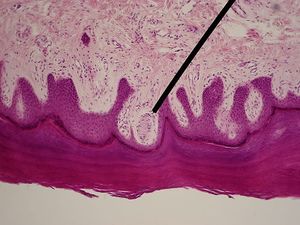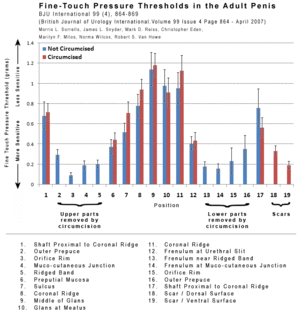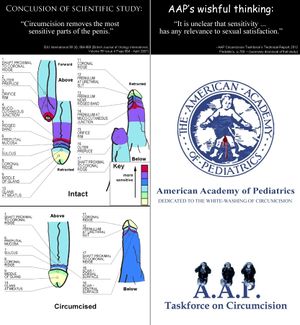Foreskin sensitivity
Anatomical investigations have identified the prepuce as a primary erogenous zone in humans.[1] Falliers (1970) commented on the "sensory pleasure induced by tactile stimulation of the foreskin."[2]
For over a hundred years, anatomical research has confirmed that both the penile and clitoral prepuce (foreskin) are richly innervated, specific erogenous tissue with specialised encapsulated (corpuscular) sensory receptors, such as Meissner's corpuscles,[3] Pacinian corpuscles, genital corpuscles, Krause end bulbs, Ruffini corpuscles, and mucocutaneous corpuscles. These receptors transmit sensations of fine touch, pressure, proprioception, and temperature.[4][5][6][7][8][9][10][11][1][12]
Contents
Nerve types
The two primary sensory receptors in primate skin are free nerve endings and encapsulated or corpuscular receptors. While free nerve endings (pain, itch, and temperature receptors) are found in most skin, the encapsulated receptors are concentrated in regions that require specialised touch sensitivity, such as at the fingertips, lips, external genitalia, perianal skin, and transition areas between skin and mucous membranes.[13]
The innervation of the foreskin is impressive [14] The foreskin is what's known as a specific erogenous zone.[1] This means that it is richly equipped with a high density and concentration of specialized and sophisticated nerve receptors that convey pleasure.[3] The presence of specialized nerves, nerves that do no not exist elsewhere, make this part of the penis especially important. Consequently, this has been studied in detail by respected anatomists for over a century, who have transformed their knowledge by detailed empirical observation of the nerves that are present in the foreskin.
As the most richly innervated part of the penis, the foreskin has the largest number of nerve receptors, as well as the greatest variety of nerve receptors.[3] These specialized nerve endings include:
- Corpuscles of Ruffini,[16]
- Pacinian corpuscles,[6]
- genital end bulbs [17]
- Genital bodies,[6]
- Merkels disks, Golgi-Mazzoni corpuscles,[6]
- and Vater-Pacinian corpuscles.[9]
These remarkable organs provide the foreskin with its amazing ability to detect the slightest sensations of touch, motion, temperature, and pressure. We are still unaware of all the facts about these fascinating structures. Future research may discover even more nerve receptors in the foreskin and help clarify what purposes they serve. The primary zones of erogenous sensitivity are the frenulum, ridged band of mucosa, and the preputial orifice and the external fold of the foreskin. All of these zones are orgasmic triggers. Continuous gentle stimulation of any one of these areas can elicit pleasure, erection, orgasm, and ejaculation. Some men report that simple retraction of their foreskin causes erection.
Meissner's corpuscles
Distributed on various areas of the skin, but concentrated in areas especially sensitive to light touch, such as the fingers, lips, nipples and foreskin.[18][19][20][21][22] They are concentrated in areas of the body denoted as erogenous zones, which include the foreskin, clitoris, lip and nipple.[1] J. R. Taylor (1996) noted their presence in the foreskin,[15] and C.J. Cold & Taylor (1999) reported "Most of the encapsulated receptors of the foreskin are Meissner corpuscles, as they contact the epithelial basement membrane."[23] Early observations were noted by A.S. Dogiel (1893),[4] D. Ohmori (1924),[6] and H. C. Bazett (1935),[24] reported the presence of Meissner's corpuscles in the foreskin. Haiyang et al. (2005) found and measured the density of Meissner's corpuscles on the foreskin.[25] Dong et al. (2007) reported that the quantity of Meissner's corpuscles on the fused smooth mucosa of the foreskin decline with age, but not on the ridged band.[26]
Ridged Band
In 1991 the ridged band of the male prepuce was identified as a concentrated area of corpuscular receptors.[15]
Fine-touch sensitivity
The foreskin has important sexual nerve receptors that are removed during circumcision.[9][1][15][27] Circumcision removes the most sensitive part of a man's penis. The five most sensitive areas of the penis are on the foreskin. The transitional region from the external to the internal foreskin is the most sensitive region of the fully intact penis, and more sensitive than the most sensitive region of the circumcised penis.[28]
In a 2007 study, which was published in BJU International. They physically measured the sensitivity of all the parts of the penis. They used a very accurate pressure sensing probe while the test subject, who’s view was blocked with a screen, reported a sensation of touch. To demonstrate precision they took each measurement multiple times. To no surprise, their results corroborated with the neuro-anatomy that has been discussed previously.
"Five locations on the foreskinned penis that are routinely removed at circumcision were more sensitive than the most sensitive location on the circumcised penis[...] The glans in the circumcised male is less sensitive to fine-touch pressure than the glans of the uncircumcised male[...]The most sensitive location on the circumcised penis is the circumcision scar on the ventral surface [...] When compared to the most sensitive area of the circumcised penis, several locations on the uncircumcised penis that are missing from the circumcised penis were significantly more sensitive."[28]
AAP discards its former Circumcision Policy Statement
In the AAP's 2012 Circumcision Task force report, the issues of sensitivity reduction were given obligatory mention but largely glossed over, and little space was devoted to the topic. The 2012 Task Force Report received overwhelmingly heavy critical comment. The purpose of the disastrous, now expired AAP 2012 report was to encourage neonatal non-therapeutic circumcision and third-party payment so little or nothing was said about the multiple functions of the foreskin.[29] The failed 2012 AAP Circumcision Policy expired in 2017 and has not been re-affirmed or re-validated in any way. The AAP currently has no circumcision policy and does not recommend circumcision of boys.
Sorrells study of penis fine-touch sensation.
At right is an easy-to-understand illustration of the Sorrells study[28] showing the loss of tissues. Tissues show in color their relative sensitivity thresholds to light touch. sensitive tissue. On the infographic's opposite side: The AAP's expressed skepticism (quotes from their now expired 2012 Circumcision task force report) on whether loss of all that erogenous tissue could really affect sexual enjoyment.
Arguably, claiming there's no evidence that circumcision diminishes sexual enjoyment is essentially implying the obverse: that it's perfectly safe and reasonable to assume that the human foreskin, despite evolving over millions of years, has no anatomical significance in sexual mechanics, and has zero relevance to sexual pleasure and satisfaction. That statement sounds immediately absurd, however.
García-Mesa et al. (2021) reported: "[s]timulation of genital Meissner's corpuscles gives rise to sexual sensations."[3]
The circumcised penis
The nerves and other structures mentioned in this article are largely missing on the circumcised penis.
Intact men who elect to be circumcised frequently report very substantial loss of sensation after circumcision.
See also
- Acroposthion
- Gliding action
- Masturbation
- Pre-ejaculate
- Regret men
- Sexual effects of circumcision
- Sex with phimosis
- The Penis - Sex Education 101
External links
 Ball, Peter (2006):
Ball, Peter (2006): Chapter 16
, in: A Survey of Subjective Foreskin Sensation in 600 Intact Men. Work: Bodily Integrity and the Politics of Circumcision. George C. Denniston, Pia Grassivaro Gallo, Frederick M. Hodges, Marilyn Fayre Milos, and Franco Viviani (eds.). Edition: First. Springer. Pp. 177-188. ISBN 9789048172252. Retrieved 23 February 2022.
Quote:I believe that many women and most circumcised men are totally unaware of the role that the foreskin plays in the enjoyment of sex.
 Anonnymous.
Anonnymous. The Tantric Intact Penis
, Circumstitions. Retrieved 8 January 2022. Helard, Lou (1 August 2014).
Helard, Lou (1 August 2014). Functions of the Foreskin
, Intact Australia. Retrieved 29 May 2020. Anonymous (17 February 2024).
Anonymous (17 February 2024). What Do The Eyelids, Lips, Fingertips & The Intact Penis Have in Common?
, Intact America. Retrieved 18 February 2024.
References
- ↑ a b c d e
 Winkelmann RK. The erogenous zones: their nerve supply and significance. Mayo Clin Proc. 21 January 1959; 34(3): 39-47. PMID. Retrieved 4 June 2021.
Winkelmann RK. The erogenous zones: their nerve supply and significance. Mayo Clin Proc. 21 January 1959; 34(3): 39-47. PMID. Retrieved 4 June 2021.
- ↑
 Falliers CJ. Circumcision. JAMA. December 1970; 214(12): 2194. PMID. Retrieved 17 November 2021.
Falliers CJ. Circumcision. JAMA. December 1970; 214(12): 2194. PMID. Retrieved 17 November 2021.
- ↑ a b c d e
 García-Mesa, Yolanda, García-Piqueras, Jorge, Cobo, Ramón, Martín-Cruces, José, Suazo, Iván, García-Suárez, Olivia, Feito, Jorge. Sensory innervation of the human male prepuce: Meissner's corpuscles predominate. Journal of Anatomy. October 2021; 239(4): 892-902. PMID. PMC. DOI. Retrieved 15 November 2021.
García-Mesa, Yolanda, García-Piqueras, Jorge, Cobo, Ramón, Martín-Cruces, José, Suazo, Iván, García-Suárez, Olivia, Feito, Jorge. Sensory innervation of the human male prepuce: Meissner's corpuscles predominate. Journal of Anatomy. October 2021; 239(4): 892-902. PMID. PMC. DOI. Retrieved 15 November 2021.
- ↑ a b c
 Dogiel AS. Die Nervenendigungen in der Schleimhaut der äusseren Genitalorgane des Menschen [Nerve endings in a mucous membrane of external genital organs of the human] (German). Archiv für Mikroskopische Anatomie. 1893; 41: 585-612. Retrieved 21 June 2021.
Dogiel AS. Die Nervenendigungen in der Schleimhaut der äusseren Genitalorgane des Menschen [Nerve endings in a mucous membrane of external genital organs of the human] (German). Archiv für Mikroskopische Anatomie. 1893; 41: 585-612. Retrieved 21 June 2021.
- ↑
 Dogiel AS. [h Über die Nervenendapparate in der Haut des Menschen] [About the nerve end apparatuses in the human skin] (German). Ztschr Wiss Zool. 1903; 75: 46-111. Retrieved 21 June 2021.
Dogiel AS. [h Über die Nervenendapparate in der Haut des Menschen] [About the nerve end apparatuses in the human skin] (German). Ztschr Wiss Zool. 1903; 75: 46-111. Retrieved 21 June 2021.
- ↑ a b c d e
 Ohmori D. Über die Entwicklung der Innervation der Genitalapparate als peripheren Aufnahmeapperat der genitalen Reflexe [About development of the innervation of the genital apparatuses as a peripheral recording device of the genital reflexes] (German). Zeitschrift für Anatomie und Entwicklungsgeschichte. 1924; 70(1): 347-410. Retrieved 21 June 2021.
Ohmori D. Über die Entwicklung der Innervation der Genitalapparate als peripheren Aufnahmeapperat der genitalen Reflexe [About development of the innervation of the genital apparatuses as a peripheral recording device of the genital reflexes] (German). Zeitschrift für Anatomie und Entwicklungsgeschichte. 1924; 70(1): 347-410. Retrieved 21 June 2021.
- ↑
 Yamada K. Studies in the innervation in tenth month human embryo. Tohoku J Exper Med. 1951; 54: 151.
Yamada K. Studies in the innervation in tenth month human embryo. Tohoku J Exper Med. 1951; 54: 151.
- ↑
 Yamada K. On the sensory nerve terminations in clitoris in human adult. Tohoku J Exper Med. 54: 163-174.
Yamada K. On the sensory nerve terminations in clitoris in human adult. Tohoku J Exper Med. 54: 163-174.
- ↑ a b c
 Winkelmann RK. The cutaneous innervation of human newborn prepuce. Journal of investigative dermatology. 1956; 26(1): 53–67. PMID. Retrieved 30 April 2020.
Winkelmann RK. The cutaneous innervation of human newborn prepuce. Journal of investigative dermatology. 1956; 26(1): 53–67. PMID. Retrieved 30 April 2020.
- ↑
 Winkelmann RK. The mucocutaneous end-organ. Arch Dermatol. 1957; 76: 225-235. Retrieved 21 June 2021.
Winkelmann RK. The mucocutaneous end-organ. Arch Dermatol. 1957; 76: 225-235. Retrieved 21 June 2021.
- ↑
 Krantz KE. Innervation of the human vulva and vagina: a microscopic study. Obstet Gynecol. 1958; 12: 382-96. Retrieved 21 June 2021.
Krantz KE. Innervation of the human vulva and vagina: a microscopic study. Obstet Gynecol. 1958; 12: 382-96. Retrieved 21 June 2021.
- ↑
 Butler AB, Hodos W (1996): Comparative Vertebrate Neuroanatomy: Evolution and Adaptation. Edition: 26. Wiley-Liss. ISBN 0471210056.
Butler AB, Hodos W (1996): Comparative Vertebrate Neuroanatomy: Evolution and Adaptation. Edition: 26. Wiley-Liss. ISBN 0471210056.
- ↑
 Stenn KS, Bhawan J (1990):
Stenn KS, Bhawan J (1990): The normal histology of the skin
, in: Pathology of the Skin. Farmer E.R. / Hood A.F. (eds.). Norwalk, CT: Appleton and Lange. - ↑
 Moldwin RM, Valderrama E. Immunohistochemical analysis of nerve distribution patterns within preputial tissues. J Urol. April 1989; 141(4): 499A.
Moldwin RM, Valderrama E. Immunohistochemical analysis of nerve distribution patterns within preputial tissues. J Urol. April 1989; 141(4): 499A.
- ↑ a b c d
 Taylor JR, Lockwood AP, Taylor AJ. The prepuce: specialized mucosa of the penis and its loss to circumcision. Br J Urol. 1996; 77: 291-5. PMID. DOI. Retrieved 23 September 2019.
Taylor JR, Lockwood AP, Taylor AJ. The prepuce: specialized mucosa of the penis and its loss to circumcision. Br J Urol. 1996; 77: 291-5. PMID. DOI. Retrieved 23 September 2019.
- ↑ a b
 Bazett HC, McGlone B, Williams RG, Lufkin HM. Depth, distribution and probable identification in the prepuce of sensory end-organs concerned in sensations of temperature and touch; thermometric conductivity. Archives of Neurology and psychiatry. 1 March 1932; 27(3): 489-517. Retrieved 27 April 2020.
Bazett HC, McGlone B, Williams RG, Lufkin HM. Depth, distribution and probable identification in the prepuce of sensory end-organs concerned in sensations of temperature and touch; thermometric conductivity. Archives of Neurology and psychiatry. 1 March 1932; 27(3): 489-517. Retrieved 27 April 2020.
- ↑
 Halata Z, Munger BL. The neuroanatomical basis for the protopathic sensibility of the human glans penis. Brain Res. 23 April 1986; 371(2): 205-230.
Halata Z, Munger BL. The neuroanatomical basis for the protopathic sensibility of the human glans penis. Brain Res. 23 April 1986; 371(2): 205-230.
- ↑
 Cauna N, Ross LL. The fine structure of Meissner's touch corpuscles of human fingers. Journal of Cell Biology. 1960; 8(2): 467-482. DOI.
Cauna N, Ross LL. The fine structure of Meissner's touch corpuscles of human fingers. Journal of Cell Biology. 1960; 8(2): 467-482. DOI.
- ↑
 Hoffmann, et al. Meissner corpuscles and somatosensory acuity. Anat Rec A Discov Mol Cell Evol Biol. 2004; : 1138.1147.
Hoffmann, et al. Meissner corpuscles and somatosensory acuity. Anat Rec A Discov Mol Cell Evol Biol. 2004; : 1138.1147.
- ↑
 Bongiorno, et al. Neurofibromatosis of the nipple-areolar area: a case series. Journal of Medical Case Reports. 27 December 2010; 4(22) DOI.
Bongiorno, et al. Neurofibromatosis of the nipple-areolar area: a case series. Journal of Medical Case Reports. 27 December 2010; 4(22) DOI.
- ↑
 Martini, Bartholomew (2010): Essentials of Anatomy and Physiology. Edition: 3. Pearson Benjamin Cummings.
Martini, Bartholomew (2010): Essentials of Anatomy and Physiology. Edition: 3. Pearson Benjamin Cummings.
- ↑
 Afifi, Bergman (1998): Functional neuroanatomy: text and atlas. Edition: 16. McGraw-Hill Professional. ISBN 0070015899.
Afifi, Bergman (1998): Functional neuroanatomy: text and atlas. Edition: 16. McGraw-Hill Professional. ISBN 0070015899.
- ↑
 Cold CJ, Taylor JR. The prepuce. British Journal of Urology International. 1999; 83: 34-44. PMID.
Cold CJ, Taylor JR. The prepuce. British Journal of Urology International. 1999; 83: 34-44. PMID.
- ↑
 Bazett HC. Methods of investigation of sensation in man and the theoretical value of the results obtained. Proc A Research Nerv Ment Dis. 1935; 15: 83-97.
Bazett HC. Methods of investigation of sensation in man and the theoretical value of the results obtained. Proc A Research Nerv Ment Dis. 1935; 15: 83-97.
- ↑
 Haiyang, et al. Observation of Meissner's corpuscle in abundant prepuce and phimosis. Journal of Modern Urology. 2005;
Haiyang, et al. Observation of Meissner's corpuscle in abundant prepuce and phimosis. Journal of Modern Urology. 2005;
- ↑
 Dong, et al. Observation of Meissner's corpuscle on fused phimosis. Journal of Guangdong Medical College. 2007;
Dong, et al. Observation of Meissner's corpuscle on fused phimosis. Journal of Guangdong Medical College. 2007;
- ↑
 Cold CJ, Taylor JR. The prepuce. British Journal of Urology International. 1999; 83: 34-44. PMID.
Cold CJ, Taylor JR. The prepuce. British Journal of Urology International. 1999; 83: 34-44. PMID.
- ↑ a b c
 Sorrells ML, Snyder JD. Fine-touch pressure thresholds in the adult penis. BJU International. 22 October 2007; 99(4): 864–869. PMID. Retrieved 10 September 2019.
Sorrells ML, Snyder JD. Fine-touch pressure thresholds in the adult penis. BJU International. 22 October 2007; 99(4): 864–869. PMID. Retrieved 10 September 2019.
- ↑
 Hill, George: Commentary on American Academy of Pediatrics 2012 Circumcision Policy Statement
Hill, George: Commentary on American Academy of Pediatrics 2012 Circumcision Policy Statement  , Doctors Opposing Circumcision (D.O.C.). (1 April 2013). Retrieved 2 April 2022.
, Doctors Opposing Circumcision (D.O.C.). (1 April 2013). Retrieved 2 April 2022.


